Competition At The Mid-Range

Both Nvidia and AMD have recently launched a new wave of video cards aimed at the PC players who want high-end performance at a mid-range price. These new GPUs expand the wealth of options for those on tighter budgets, and as you’ll see in our benchmark tests, deliver impressive performance in relation to their predecessors. But the old question for PC gaming enthusiasts is relevant now more than in recent years: AMD or Nvidia? Well, it depends.
While Nvidia has largely remained unchallenged in the most expensive category with the RTX 2080 Ti, its begun to diversify its affordable options by offering a reasonable entry points for the relatively new ray tracing tech–namely, the RTX 2070 and RTX 2060 cards. Now, we have souped up versions aptly named the RTX 2070 Super and RTX 2060 Super. Nvidia’s RTX lineup now has incremental steps between each pricing tier, but these new cards perform well enough (relative to their price point) to render base models obsolete.
AMD, on the other hand, has been largely playing catch-up. The Radeon VII, which launched in February this year, was the company’s strongest GPU yet but had trouble keeping up with its Nvidia’s counterpart. However, AMD has made good on its approach of being the brand that brings value–not only is AMD offering aggressive pricing, its new RX 5700 XT and RX 5700 have the performance to back it up.
For those who count every dollar when it comes to building PCs or upgrading their existing rig, it’s an exciting time to make the jump for a new GPU. The competition is strong, and regardless of your choice, you’re getting plenty of performance for your dollar. In this comparison and review of the new RTX Super and Radeon RX cards, you’ll see how these sub-$500 cards stack against each other.
The products discussed here were independently chosen by our editors. GameSpot may get a share of the revenue if you buy anything featured on our site.
RTX 2070 Super And RTX 2060 Super Details

As the names indicate, the “Super” moniker for this subseries of video cards are beefier versions of their original models. For example, the RTX 2070 Super sports more shader cores, RT cores, CUDA cores, and texture units than the RTX 2070, and also has a higher base and boost clock speed–all of that translates to better performance. It also means that TDP has increased slightly from 175W on the 2070 to 215W on the 2070 Super.
What’s more is the card ends up performing a lot closer to that of an RTX 2080. At an MSRP of $500 USD, it packs more than enough punch to justify its price point. The RTX 2060 Super follows the same philosophy packing more CUDA cores, RT cores, and texture units than the standard RTX 2060–but it also features an expanded memory bus to match that of the RTX 2070 cards and up. What’s probably more important for potential buyers is that it retails for just $400.
You can’t talk about Nvidia’s video cards without mentioning ray tracing, which the company has been spearheading with the RTX family of cards. Ray tracing fundamentally changes the way games render lighting, shadows, and reflections. This won’t show up in the performance charts, but it makes a noticeable difference, though it’s up to developers if and how they want to use it. Ray tracing is made possible with Nvidia’s multi-core Turing GPU architecture, allowing the RT cores to take care of the additional workload while the rest of the GPU handles of the main graphics processing. This is an inherent advantage that Nvidia has over AMD right now, so if ray tracing interests you, you’ll have to go with Nvidia.
See the RTX 2070 Super at Amazon
See the RTX 2060 Super at Amazon
Radeon RX 5700 XT and RX 5700 Details

Both the Radeon RX 5700 XT and Radeon RX 5700 sport the all-new Navi architecture, built on the smaller, more efficient 7nm FinFET manufacturing process (Nvidia’s cards are 12nm FinFET). While Radeon VII was also a 7nm chip, its Vega 20 architecture and use of HBM2 memory wasn’t very efficient, especially compared to what Navi now offers. Going further back than the Radeon VII, AMD’s new cards pretty much put the Vega 56 and Vega 64 to rest.
These new Radeon RX cards look very similar on paper with their 8GB of GDDR6 VRAM, 256-bit memory bus, and 256 texture units (among other specs). They both use a 8-pin + 6-pin power connector, and the Rx 5700 XT’s TDP is rated at 225W while the RX 5700 is at 185W. The RX 5700 XT has a leg up on the RX 5700 with extra compute units, additional stream processors, and higher clock speeds, which translate to a notable upgrade in performance. And the kicker is that the RX 5700 XT and RX 5700 have MSRPs of $400 and $350, respectively.
See the RX 5700 XT at Amazon
See the RX 5700 at Amazon
Test Bench Specs

For the purposes of testing the new GeForce RTX and Radeon RX cards, we used a high-end test bench. It’s the same one we used for our previous reviews of the first GeForce RTX and Radevon VII cards. Our system is equipped with the following specs:
- Processor: Intel Core i7-8700K CPU (6-core / 12-thread, 3.7 GHz)
- Motherboard: ASUS ROG Maximus X Hero
- CPU Cooler: NZXT Kraken X62 liquid CPU cooler
- Memory: 16GB (8GB x 2) HyperX Fury DDR4-2400MHz RAM
- Storage: 1TB Samsung 970 EVO m.2 NVMe SSD
- Power Supply: EVGA SuperNOVA 850-watt 80+ Gold PSU
- Operating System: Windows 10 64-bit Home Edition
In order to get a clearer picture of where the new RTX and Radeon cards stand against other high-end options, we tested three additional cards alongside them for a total of seven cards in our tests. At the time of testing, we used the latest GeForce driver version 431.36 for Nvidia cards and the official Radeon Software version 19.71 for AMD cards. Every Nvidia card is a Founders Edition model, and all AMD cards are reference cards:
- Nvidia GeForce RTX 2080 – Launch Price: $700
- Nvidia GeForce RTX 2070 Super – Launch Price: $500
- Nvidia GeForce RTX 2070 – Launch Price: $500
- Nvidia GeForce RTX 2060 Super – Launch Price: $400
- AMD Radeon VII – Launch Price: $700
- AMD Radeon RX 5700 XT – Launch Price: $400
- AMD Radeon RX 5700 – Launch Price: $350
Testing Methodology And Benchmark Results

To evaluate each of the new video cards, we included the RTX 2080 since it is the next step up from the RTX 2070 Super and helps bookend our tests. We also brought the base model RTX 2070 to show the relative performance of the Super versions. To paint a clearer picture of where the Radeon RX cards stand, we included AMD’s strongest card prior, the Radeon VII–this also shows just how powerful the new cards are, especially relative to their price.
For measuring performance, we chose seven games that feature comprehensive in-game benchmark tools to represent the more graphically demanding side of PC gaming. Each card was put through each benchmark test in 4K and 1440p resolutions with the highest graphics quality settings available in the respective game. Numbers in the charts below represent the average FPS from every test with the exception of Final Fantasy XV which produces an overall score. The results can be seen below.
Metro Exodus
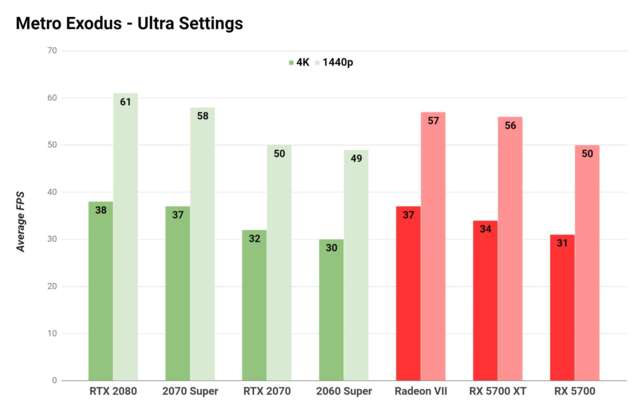
Metro Exodus is the premier graphical showcase for PC games in 2019 so far; it also has a convenient benchmarking tool that can push your system to its limits. For these tests, we used the Ultra graphics preset without any brand-specific options enabled. While Metro Exodus is one of the best showcases of ray tracing, we turned it off in order to keep our settings consistent across the board.
Right out of the gate, AMD makes a bold statement with the performance of the RX 5700 XT and RX 5700, both of which outperform the similarly priced RTX 2060 Super–the RX 5700 XT also comes close on a 60 FPS average at 1440p resolution. The RTX 2070 Super manages a few extra FPS on average over the RX 5700 XT and comes really close to the RTX 2080.
Assassin’s Creed Odyssey
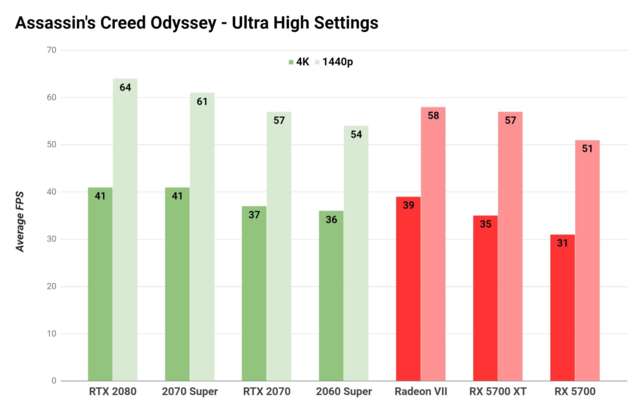
Assassin’s Creed Odyssey features expansive environments to bring its version of ancient Greece alive, and the built-in benchmark tool can give a good indication of how your system will handle the game. We used the Ultra High preset for these tests which includes a number of post-processing effects, HBAO+, TAA, and more.
Performance is fairly close between the RTX 2060 Super and RX 5700 XT, trading blows in 1440p and 4K, although the differences are largely negligible. Nvidia has a strong showing here in AC Odyssey with the RTX 2070 Super getting the edge on all the new cards. Like Metro Exodus, we see it Super performing almost identically to the RTX 2080, which is exciting to see from a cheaper card.
Final Fantasy XV
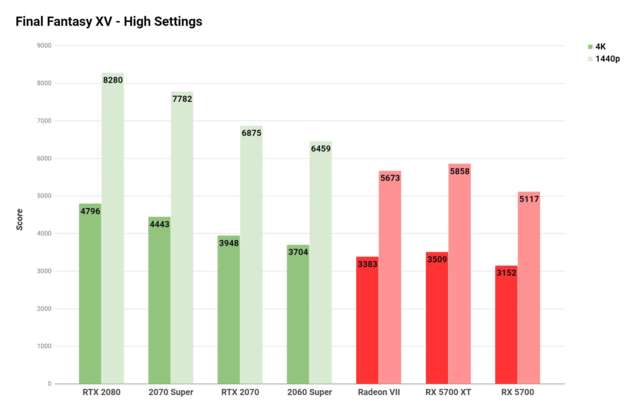
Final Fantasy XV has a benchmark tool that you can download for free. Its world of Eos makes for one of the more stunning visual showcases for PC games, and it’ll also ask a lot from your hardware. We used the High quality preset for all tests. FFXV’s benchmark also doesn’t give an FPS reading, but rather a cumulative score that can roughly translate to 100-times the average FPS.
FFXV tends to struggle with AMD cards, resulting in stuttering in certain sections of the benchmark, and unfortunately this reflects poor overall performance. As for Nvidia’s lineup, again we see the RTX 2070 Super perform very close to the RTX 2080, and the RTX 2060 Super come close to the RTX 2070. Even as the RX 5700 XT lags behind, its 4K performance isn’t far from the RTX 2060 Super.
Forza Horizon 4

The Forza series has always been a graphical showcase, and the latest game, Forza Horizon 4, is no different. It features a ton of graphics options and we cranked everything to Extreme settings in its comprehensive benchmark that spans a full race with various weather effects.
AMD’s cards perform incredibly well here; the RX 5700 XT is on par with the upper-tier RTX 2070 Super in 4K and outclasses it in 1440p. Even the standard RX 5700 can keep up at 1440p and doesn’t trail too far behind in 4K. Nvidia’s cards steadily scale in performance as you go up in tier, but only the RTX 2070 Super will match the RX 5700 XT at 4K. At 1440p, the RX 5700 even matches the RTX 2070 Super’s performance.
Shadow of the Tomb Raider

Shadow of the Tomb Raider was one of the best looking games from 2018 and had a bunch of graphical features–its highest preset includes HBAO+, tessellation, and volumetric lighting (ray tracing is also available for RTX users). Its expansive environments and detailed jungles also make for intense video card tests.
Here, the RTX 2070 Super lands right in the middle of the RTX 2070 and RTX 2080, with the latter standing firm atop all the others. AMD isn’t too far behind as the RX 5700XT handily beats out its direct competitor, the RTX 2060 Super and even surpasses the RTX 2070.
Middle-earth: Shadow of War
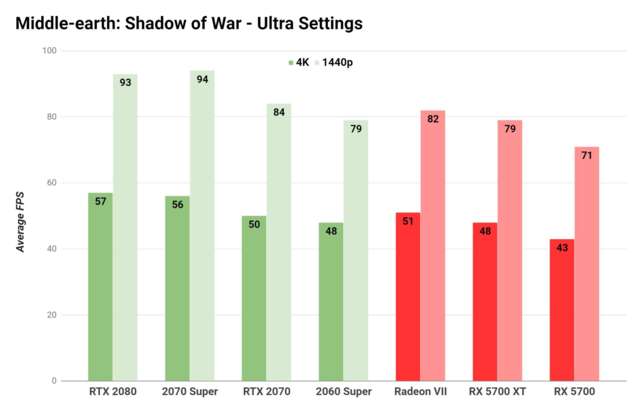
Middle-earth: Shadow of War may not be the best-looking game on the list, but it’s benchmark still pushes the latest video cards. You have tons of options like tessellation, ambient occlusion, vegetation range, mesh quality, and more.
Nvidia pulls ahead ever so slightly as AMD holds its own here, though; when accounting for price, The RX 5700 XT and RTX 2060 Super provide the same value since they perform identically. Jumping to the RTX 2070 Super does offer a noticeable bump, but all cards manage to put up playable frame rates at 4K.
Deus Ex: Mankind Divided
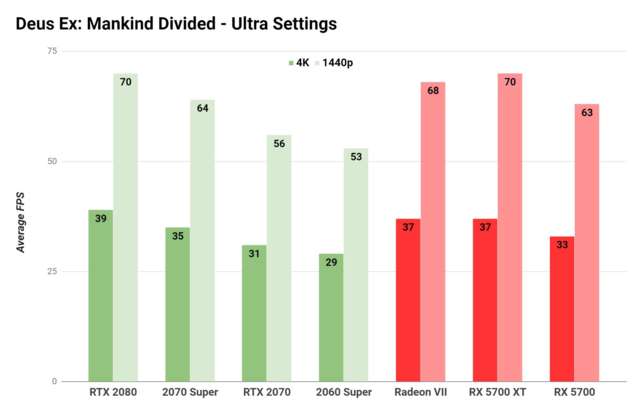
Like Forza Horizon 4, Deus Ex: Mankind Divided is another game that’s optimized for AMD cards. Its in-game benchmark is also known for being very demanding despite it being a camera fly-through of an indoor environment.
The RX 5700 XT stands toe-to-toe with the high-end RTX 2080 at 1440p and only trails by two-frames in 4K, which is very impressive. Even the cheaper RX 5700 performs very close to the RTX 2070 Super.
Temperatures
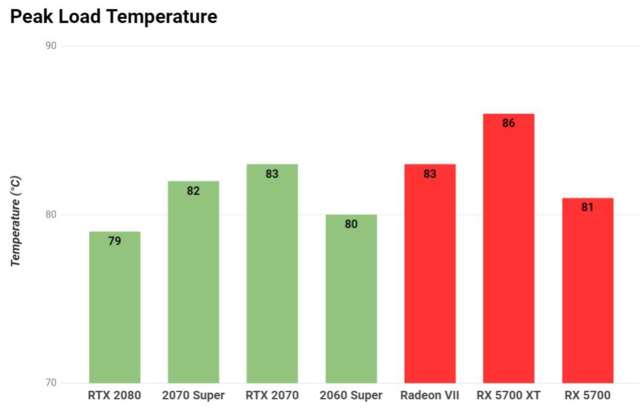
As for temperatures, peak load for each card didn’t show anything out of the ordinary, though its worth noting that the RX 5700 XT will run the hottest. Your mileage will of course vary between third-party manufacturers such as Gigabyte, ASUS, Zotac, and others. As mentioned earlier, all the cards we used were reference models.
Peak load temps were recorded using CPUID HWMonitor after going through the gamut of benchmarks by running Metro Exodus at 4K a second time.
Verdict

Every generation of video cards will have AMD or Nvidia outperforming one another in certain games that optimize for either manufacturer. And while they trade blows from time to time, each brand stands out in their own right. The RX 5700 XT is largely the top performer in its price range, providing great value for frames-per-second. So unless you’re sold on Nvidia’s ray tracing technology or suite of tools via GeForce experience, AMD’s lineup has some attractive options.
If you’re willing to spend enough to get into the upper tier, the RTX 2070 Super impresses from a different perspective. Not only is its performance much closer to the high-end RTX 2080, but it gets there at a much lower price. For prospective buyers, this essentially makes the RTX 2080 and RTX 2070 obsolete. Those who have either of those cards, however, are still sitting pretty with ray tracing capabilities and great FPS output. As for the RTX 2060 Super, it’s a good card in isolation since it encroaches on the RTX 2070’s territory, but the RX 5700 XT being in the same price range makes it a bit of a tougher sell.
PC gaming enthusiasts shouldn’t sleep on what Nvidia is doing with ray tracing–more and more developers are adopting the tech and its fundamentally changing the way games present lighting, shadows, and reflections. You can see it in games like Battlefield V and Metro Exodus, and upcoming games like Control and Atomic Heart further showcase how distinct ray tracing can be. AMD still has some catching up to do on that front, but has capitalized on offering the lineup that gives you more bang for your buck FPS-wise.